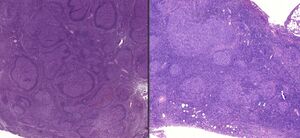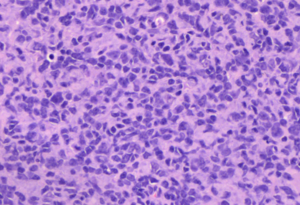16. Follicular lymphoma: Difference between revisions
Created page with "'''Staining''': HE '''Organ''': Lymph node with perinodal fat '''Description''': Abnormal follicles are visible. These follicles are made up of tumor cells and are therefore called neoplastic follicles. The tumor cells show only mild atypia/pleiomorphism. The neoplastic follicles have broken mantle zone and shows no “starry sky” pattern. The neoplastic follicles infiltrate the perinodal fat tissue. The tissue between the neoplastic follicles appears compressed...." |
No edit summary |
||
| (4 intermediate revisions by the same user not shown) | |||
| Line 1: | Line 1: | ||
'''Staining''': HE | [[File:Follicular lymphoma - overview.jpg|thumb|Overview]]'''Staining''': HE . '''Organ''': Lymph node with perinodal fat | ||
'''Description''': Abnormal follicles are visible. These follicles are made up of tumor cells and are therefore called neoplastic follicles. The tumor cells show only mild atypia/pleiomorphism. The neoplastic follicles have broken mantle zone and shows no “starry sky” pattern. The neoplastic follicles infiltrate the perinodal fat tissue. The tissue between the neoplastic follicles appears compressed.[[File:Follicular lymphoma - mantle zone.png|thumb|No starry sky pattern. The mantle zone (the ring of darker stained cells) is incomplete as it is broken on the bottom aspect.]] | |||
'''Description''': | |||
Abnormal follicles are visible. These follicles are made up of tumor cells and are therefore called neoplastic follicles. The tumor cells show only mild atypia/pleiomorphism. The neoplastic follicles have broken mantle zone and shows no “starry sky” pattern. The neoplastic follicles infiltrate the perinodal fat tissue. | |||
The tissue between the neoplastic follicles appears compressed. | |||
'''Diagnosis''': Follicular lymphoma | '''Diagnosis''': Follicular lymphoma | ||
'''Causes''': | '''Causes''': t(14;18) translocation – fusion of BCL2 and IgH[[File:Follicular lymphoma - compression.png|thumb|The area between the neoplastic follicles is compressed]]'''Theory''': The translocation of the IgH gene (with its highly active promoter region) into the BCL2 (an antiapoptotic protein) on chromosome 18 causes the BCL2 gene to be overexpressed. These cells therefore have high antiapoptotic activity. Due to this is there no apoptosis in the follicles, so the “starry sky” pattern not visible.[[File:Follicular lymphoma - comparison with physiology.jpg|thumb|Left: Physiological follicular hyperplasia. Right: Follicular lymphoma. The slides are not at the same magnification. The follicles in follicular lymphoma have less prominent and more incomplete mantle zones. Compare the “starry sky” pattern.|none]] | ||
[[File:Follicular lymphoma - pleomorphism.png|thumb|The tumor cells show only mild atypia. This is taken from a neoplastic follicle.|none]] | |||
'''Theory''': | |||
The translocation of the IgH gene (with its highly active promoter region) into the BCL2 (an antiapoptotic protein) on chromosome 18 causes the BCL2 gene to be overexpressed. These cells therefore have high antiapoptotic activity. Due to this is there no apoptosis in the follicles, so the “starry sky” pattern not visible. | |||
[[File:Follicular lymphoma - comparison with physiology.jpg | |||
[[File:Follicular lymphoma - pleomorphism.png | |||
[[Category:Pathology 2 - Histopathology slides]] | [[Category:Pathology 2 - Histopathology slides]] | ||
Latest revision as of 13:45, 7 July 2024
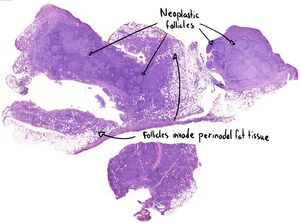
Staining: HE . Organ: Lymph node with perinodal fat Description: Abnormal follicles are visible. These follicles are made up of tumor cells and are therefore called neoplastic follicles. The tumor cells show only mild atypia/pleiomorphism. The neoplastic follicles have broken mantle zone and shows no “starry sky” pattern. The neoplastic follicles infiltrate the perinodal fat tissue. The tissue between the neoplastic follicles appears compressed.
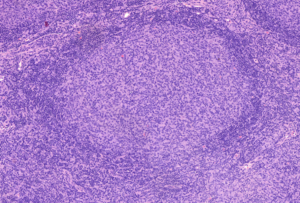
Diagnosis: Follicular lymphoma
Causes: t(14;18) translocation – fusion of BCL2 and IgH
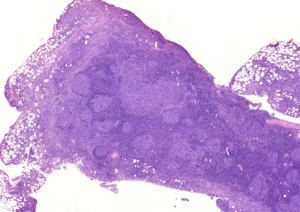
Theory: The translocation of the IgH gene (with its highly active promoter region) into the BCL2 (an antiapoptotic protein) on chromosome 18 causes the BCL2 gene to be overexpressed. These cells therefore have high antiapoptotic activity. Due to this is there no apoptosis in the follicles, so the “starry sky” pattern not visible.
